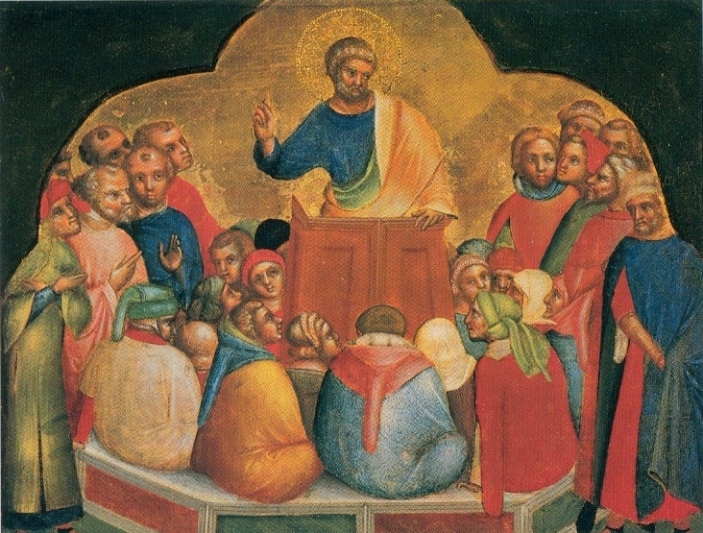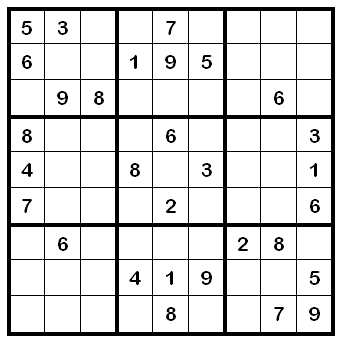 |
| Lorenzo Veneziano, Apostle Peter Preaching (1370) |
The Catholic Church teaches that the Apostolic faith, including “everything which contributes toward the holiness of life,” was “handed on once and for all” to the Apostles (Dei Verbum 8; see Jude 1:3). Jesus entrusted to the Apostles, through the power of the Holy Spirit, a Deposit of Faith, expressed in Scripture as well as Apostolic Tradition.
In saying, with Jude 1:3, that this Deposit of Faith is handed on “once for all,” the Catholic Church is rejecting both (i) the idea that this Deposit of Faith could become corrupted, and need to be restored by a mere mortal like Luther or Calvin, and (2) the idea that this Deposit of Faith would need to be added to or improved upon by some later “prophet” like Muhammad or Joseph Smith. Put more simply, if the faith Jesus established is assured (under Divine Providence) to continue from generation to generation, we can know that Protestantism, Mormonism, and Islam are false.
But in the same breath that She affirms the “once for all” of Apostolic Tradition, the Church proclaims that the “tradition which comes from the Apostles develops in the Church with the help of the Holy Spirit” (Dei Verbum 8). So what gives? Is the Church talking out of both sides of Her mouth? Is She trying to smuggle in the ability to invent new teachings, while paying lip service to the “once for all” nature of Apostolic Truth? Not at all. But to understand how these two teachings are compatible, let me indulge in a truly geeky analogy.
If you’re not familiar with how su doku is played, it’s pretty simple: you start with a 9 x 9 grid with certain numbers filled in, like this:
From this starting point, you have to deduce which numbers belong in the other rows and columns, in accordance with the following rules:
- Each of the bold 3 x 3 blocks must contain every digit from 1 – 9, with no duplicates;
- Every row must include every digit from 1 – 9, with no duplicates; and
- Every column must include every digit from 1 – 9, with no duplicates.
Those bolded numbers in the board above are revealed. We couldn’t have deduced those numbers on our own, and we couldn’t play the game without those numbers. So those numbers are necessarily a product of revelation, just as the Deposit of Faith is within Christianity.
Church history really does work somewhat similarly. We start from Divine revelation, parallel to the revealed starting numbers in the su doku analogy. We also start with a few basic rules, like that truth can’t contradict truth. Some truths necessarily flow from revelation, and these can be held with the same confidence as Divine revelation itself. These are the answers (like the 5 in the green square, in the first example), that can be written in with pen. But there are also areas where theologians venture opinions (on everything from the Trinity to Limbo). Sometimes, these theological opinions turn out to be correct; other times, they turn out to be false. The Church can learn from each. From this, we can put the pieces together.
Let’s use the doctrinal development of the Trinity as an example. Divine revelation doesn’t specifically spell out the Trinity: there’s no absolutely-clear Scriptural passage on point, for example. But revelation does give us all of the necessary pieces, by revealing that (i) Jesus is God (John 20:28), (ii) the Father is God (Col. 1:3), (iii) Jesus is distinct from the Father (John 8:42) (iv) there is only One God (1 Cor. 8:4).
From this, several heretics penciled in answers that didn’t work: that Jesus wasn’t God, or that He was almost God, or that He was a separate God from the Father, etc. Each of these answers violated at least one of the things which had been revealed. Under the guidance of the Holy Spirit, the Church determined why all of these heresies were wrong on the basis of revelation. For example, claiming that Jesus was a separate God from the Father violates the revealed truth that there’s only one God (1 Cor. 8:4); claiming that Jesus wasn’t God violates the revealed truth of His Divinity (John 20:28); claiming that Jesus was the Father violates the revealed truth that Jesus and the Father are distinct (John 8:42), etc.
So the revelation doesn’t directly spell out the Trinity, but it did give the Church all of the tools necessary to show why each of the non-Trinitarian heresies was false. In showing why each one was false, the Church more fully articulated Her own beliefs about the Trinity. Having seen that every option besides the Trinity was heretical, and violated revealed truth, the Church boldly and infallibly proclaimed.
But here’s the key: even if it can be a little laborious to solve a hard su doku puzzle, or to figure out the Trinity, the hypostatic union, and so on, the Church already has all of the tools She will ever need. So it’s legitimate doctrinal development to build off of what’s been given. It’s not legitimate doctrinal development (1) to reject what’s already infallibly known, or (2) to claim that we need some other source of truth, like a later prophet, a Newer Testament, another religion’s revealed texts, the zeitgeist, etc. The tools we need have existed from the first century, and will remain firmly in the Church’s possession until the Second Coming.


Totally inappropriate, but I think the word “sudoku” is the Japanese for: SU, meaning “number puzzle”, and DOKU, meaning “that you feel like a dope for not being able to finish”. At least that’s what I heard.
You’ve just resolved a long time internal struggle I’ve had with the Church since converting. Thank you and God bless 🙂
Awesome. And very appropriate for tomorrow’s memorial of Bl. Newman. Thanks Joe.
“Joe Heschmeyer pretty much just played Sudoku before the LSAT and got a 177. But he’s an odd case” http://www.net-benefits.net/showthread.php?t=11966
Thank you! This is the best, most clear analogy I have ever come across to explain the development of doctrine, especially for those who think Catholics just randomly pull this stuff out of thin air. I plan on using this often.
Very interesting article – thanks. If you want to read a brilliant exposition of the Trinity, I recommend the chapter in Frank Sheed’s “Theology and Sanity”.
Fantastic analogy! It can be difficult to explain the development of doctrine to “sola scriptura” types and recommending reading J.H.C. Newman’s work on the issue isn’t always the easiest sell. I find myself wondering why Ann finds this “totally inappropriate.” For anyone interested in Newman’s take on this: (http://www.amazon.com/An-Essay-Development-Christian-Doctrine/dp/1477438343/ref=sr_1_3?ie=UTF8&qid=1349795176&sr=8-3&keywords=newman+development+of+christian+doctrine)
Read Ann’s remark again. She is clearly referring to her whimsical definition of So Duko, not Joe’s analogy. See it?
The best example of the Trinity I’ve come across is the stem cell. That used to be called the Primal Cell, which was a “glob” of cells when I took Embryology many years ago. The Primal Cell was the early stage of the embryo formation and contained the three different cell types that make up the entire body. Those 3 cells are Ectoderm, Mesoderm, and Endoderm. The Primal Cell would continue reproducing those three different type cells as those cells started to form the particular part of the body they were created to make. At some point in time, the Primal Cell stopped reproducing those 3 cell types; the body parts each type cell were assigned to build then took over the responsibility of reproducing their type cells to finish building their parts of the body until completed.
The really interesting thing about the Primal Cell that I realized years later was they could never find those 3 different type cells in it. They only why science was able to identify them was when the primal cell released them to their assigned body part formation. Thus the Primal Cell contained three distinct “beings” in one. Can it be that science has proof of the reality of the Trinity?
Sudoku? Sort of, I guess. I think this verse explains the position of the Church much better though.
1 Corinthians 11:19
For there must be also heresies among you, that they which are approved may be made manifest among you.
To illustrate, a heretic appears attempting to explain the truth and the Church says, “no, that’s not it.” Then another person appears who can better explain that mystery and the Church says, “That’s it!”
Think of Athanasius vs Arius , Augustine vs all those other guys, etc. etc. Its not a matter of the Church filling in numbers (being facetious). Its a matter of God sending the Church Prophets and Teachers when we most need them.
Sincerely,
De Maria
Has there ever been a development of doctrine which was planned and considered, scheduled, so to speak? Or has all development of doctrine occurred as a response to heresies?
Thanks for this example. But I am trying to find out how to respond to the following argument:
But there are doctrines which have developed which are not “necessarily” implicated as the missing numbers are necessarily implicated. For example, if Mary was assumed into heaven or not is not an issue which destroys the gospel, since the early Church not only lived with it while Mary was still alive, but also for 1950 years. The same goes for the Immaculate Conception. Whether Mary was sanctified in conception or afterward is a speculation comparable to knowing if infants unbaptized go to hell or not, or to some limbo. It is just not something necessarily implicated by any other doctrines that were clearly revealed (the numbers given).
How would you respond to this?